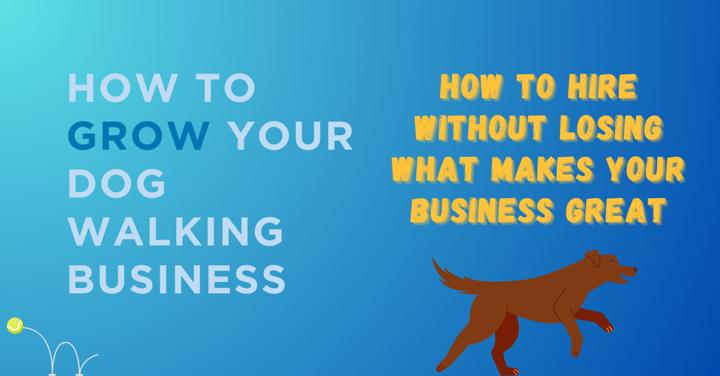
How to Hire Without Losing What Makes Your Business Great
You’re running at full speed. You’re booked solid, juggling inquiries, and starting to feel like you’ve hit a ceiling. Not because business is slow, but because there simply aren’t enough hours in the day to keep up.
Maybe you’ve thought about hiring. Maybe you've even started training someone, only to find yourself answering texts at all hours or redoing half the work. Hiring is supposed to lighten the load, not add more to your plate. So how do you get the help you need without losing control of the business you’ve worked so hard to build?
This chapter is about scaling up: what it takes to bring on walkers in a way that actually helps; what to think about before hiring; how to find the right people; how to build trust with your team; and what systems actually help even when you’re not doing every walk yourself.
Let’s Talk About Trust
At this stage, most business owners aren’t hesitant about hiring because they don’t want help, but rather they’re hesitant because they don’t trust someone else to do it right.
That’s valid. You’ve built strong relationships with your clients, you know their dogs inside and out, and you’ve likely earned that trust through consistency and communication. Handing that off feels risky.
But hiring doesn’t mean stepping back from your standards. It means creating clear expectations, consistent processes, and a support system for both you and your team. When you do that, hiring becomes a way to protect your business.
The truth is, hiring works best when it’s backed by systems. That’s exactly how one of our clients, Tails N’ Trails (founded by Carolina Oakley), was able to expand from a single location to three (in Providence, Milwaukee, and Worcester) in just over a year. She didn’t hire a huge team overnight–she built processes as she scaled that supported her team and protected the trust she had with clients. You can read her full story here.
Start with the Systems
Before you hire your first (or next) walker, check your systems and make sure you have a solid foundation to support your growing team. Can someone else understand your schedule without you explaining it? Are your client notes clear and up-to-date? Do you have a way to confirm that visits are actually happening? And just as important—have you thought through how you’ll compensate your team in a way that’s fair, predictable, and sustainable?
If the answer is “not really,” now’s the time to build that scaffolding. Compensation, in particular, deserves careful thought before you ever post a job. Decide whether you’ll pay a flat rate per visit, a percentage commission, or a mix that varies by service. The right pay structure will look different for every business, but what matters most is that your approach is consistent and clear.
Once you’ve got those pieces in place, the next challenge is keeping them organized. This is where software can make a big difference. With PetPocketbook, for example, all of this—scheduling, client notes, team permissions, check-ins, and even compensation tracking—lives in one place. Instead of juggling spreadsheets, text threads, and side notes, you’ve got a single system that keeps you organized and ready to grow.
Should You Hire ICs or Employees?
Before you bring someone onto your team, it’s important to think about whether you’ll hire independent contractors (ICs) or employees. Both options can work in pet care, but they come with different responsibilities and trade-offs.
Independent Contractors (ICs) set their own schedules, decide how they work, and often bring their own tools. You can share expectations and offer resources, but you can’t require training, dictate exact processes, or supervise them in the same way you would an employee. The benefit is flexibility and fewer administrative requirements, but you give up some control over how care is delivered.
With employees, you have the ability to set schedules, require training, and standardize processes. This makes it easier to create consistency in how visits are handled, which protects your brand and client experience. The trade-off is added responsibility for payroll, benefits, taxes, and compliance.
There’s no one “right” answer—it depends on your goals, capacity, and how much control you want to have over your team. If you’re unsure, it’s always a good idea to talk with a legal or HR professional about the best fit for your business.
How to Find the Right People
Once you’ve decided whether to hire ICs or employees, the next step is finding the right fit. No matter which path you choose, reliability, professionalism, and a genuine love of working with pets should be non-negotiable. But how you screen for those traits will look a little different depending on the role.
Start by getting clear on exactly what the role involves. Write it down. For employees, that means outlining both the core responsibilities (handling group walks, working midday shifts, walking in all weather, and following specific pet care instructions) and the soft skills (communicating professionally, respecting boundaries, and representing your brand with care). For ICs, focus more on the scope of services you’re contracting for—and look for providers who already demonstrate the skills and judgment you’d want in your business.
In a recent roundtable with us, Doug the Dog Guy walked us through how to structure your hiring process before you ever post. That means deciding where you’ll share the listing (local Facebook groups, referrals, past clients), what you’ll ask for in an application (availability, experience, references), and how you’ll screen for alignment—not just availability. For employees, that might mean focusing on availability and trainability, while for ICs, it might mean prioritizing strong references and examples of independent decision-making.
When you write your job post, be specific. Don’t just list tasks–describe what makes your business different, and what kind of person will thrive working with you. Show your personality in your writing. If it means being a little goofy, let that come through. If you’re all about structure and professionalism, lean into that. A job post written in your authentic voice helps attract candidates who will connect with your style and values. For employees, highlight culture and expectations. For ICs, highlight flexibility and the ability to manage their own schedules.
Finally, think about how you’ll evaluate candidates once they apply. Strong vetting is essential: for employees, background checks or even a short trial period can give you confidence in how they’ll handle pets and clients in real life. For ICs, put more weight on proven experience and trusted recommendations, since you won’t have the same ability to test and train them directly. Either way, a thoughtful evaluation process shows professionalism and helps protect your business.
Hiring isn’t just about finding someone who can do the work—it’s about finding someone who aligns with your values and represents your business well. Pet care is such a relationship-based business—skills matter, but so do personality and attitude.
Hiring is an Investment—So Treat It Like One
Bringing someone onto your team doesn’t end once you decide who to hire—that’s just the beginning. The real investment comes in how you prepare them to succeed. Clear expectations, consistent processes, and thoughtful onboarding will save you time later and help protect the client experience you’ve worked so hard to build.
For employees, clarity starts with documentation. An Employee Handbook or Standard Operating Procedures (SOPs) that spell out your expectations, workflows, and brand standards. Even a simple shared checklist or Google doc on the topic can go a long way toward creating consistency.
From there, resist the urge to hand over the leash immediately. At this year’s NAPPS Conference, Joe Latona shared with us how onboarding should be layered. Start with shadowing–let new hires watch how you manage a visit–then flip it to observe them in action. Pay attention to details—are they checking gates, reading client notes, handling leash behavior with confidence? These are the things clients remember. You can read our recap of Joe’s session here.
💡Quick note on ICs: If you’re working with independent contractors (ICs), there are strict legal limitations on how much control you can exert over how, when, and where they work. That means things like mandatory training, required protocols, or supervised visits may not be compliant. If you’re unsure, consult with a legal or HR professional to make sure your setup aligns with labor laws in your state.
Whether you’re working with employees or ICs, software can help you manage your team with confidence. With PetPocketbook, for example, you get real-time visibility into your team—who’s completing visits, how communication is handled, and what each person has earned. Every team member has their own login, giving you transparency without micromanaging. For employees, that means you can set permissions and assign visits directly. For ICs, they can manage their own schedules and approve appointments independently, while you still have insight into completed visits and compensation owed. Either way, you stay in control while your team has the freedom they need to do their best work.
When it comes time to actually run payroll, we recommend Gusto—the platform we use ourselves at PetPocketbook. It’s built for small businesses, keeps compliance simple, and we’ve partnered with them to offer our community an exclusive discount when signing up. You can read more about that in our latest partner spotlight.
As we learned from Doug the Dog Guy in our hiring roundtable: don’t assume new hires will deliver care exactly the way you do—show them. Walk through what a great visit looks like. Explain how you handle nervous dogs, difficult clients, or schedule changes. Talk about how and when to communicate during a visit. The clearer you are in the beginning, the fewer issues you'll run into later.
Hiring well takes upfront effort but it saves you from micromanaging down the road. And most importantly, it protects the experience your clients rely on as you grow.
You Don’t Have to Grow Fast—Just Intentionally
There’s rarely a perfect moment to hire. It’s not a clear milestone but more like a feeling. You’re stretched thin, turning down clients, and thinking, I can’t keep doing this alone. That’s your cue.
Some businesses bring on one part-time walker every few months and slowly build. Others go all-in and have a full team within a year. Both approaches work. The key is growing on purpose—not out of panic.
If you’re unsure, start small. Try adding someone just for midday coverage a couple days a week. See how it feels to assign visits. Watch how your workflow holds up. Treat it like a trial—not just for them, but also for you. Give yourself room to make adjustments. The best systems often come from what you learn after you start.
Coming Up Next
In Chapter 3, we’ll dig into how to make your business run more efficiently: so you can scale without getting buried in admin. We’ll cover automation, client self-serve tools, and how to reclaim time without losing the personal touch your clients love.
For now, here’s your takeaway:
Hiring is not about doing less. It’s about protecting what you’ve built so it can grow stronger with help.
Let it be imperfect. Let it be a work in progress. But don’t let fear of change stop you from building the support you deserve.
